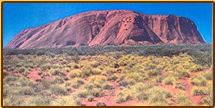 |
 |
 |
 |
 |
 |
 |
 |
 |
 |
 |
 |
 Art,
Land and the Dreaming Art,
Land and the Dreaming
|

|
 |
Art is a central part of the life of Australian aborigines and takes
many forms. Traditionally it was made for purely cultural reasons
and was only able to be created or viewed by people initiated to the
proper level of knowledge. More recently, artwork has been made specifically
for public viewing. Regardless of whether the art is for private or
public purposes, for many artists their work remains inspired by the
traditional marks and symbols from the Dreaming
and the artist's country.

Uluru is a landscape of profound
spiritual significance for Anangu Aborigines.
The Dreaming
is a term used by Aboriginal people to describe relations between
the spiritual, natural and moral elements of the world. It relates
to a period before living memory or experience - a time of creator
ancestors and supernatural beings. This period is called the Dreamtime.
Many art works are visual representations of the symbols associated
with the artist's Dreaming.
|
 Traditional
Symbols Traditional
Symbols
|
 |
Conventional designs and symbols are an essential
part of the long traditions in Aboriginal art. When applied to
the body of a person taking part in a ceremony or the surface
of an object, these have the power to transform the object to
one with religious significance. Dots are one of the conventional
symbols widely used and for many non-Aboriginal people these are
what give Central and Western Desert art its distinctive character.
|
|
 Aborigines with sand painting
and body painting - from Spencer-Gillen expedition to Central
Australia in 1912
Aborigines with sand painting
and body painting - from Spencer-Gillen expedition to Central
Australia in 1912 |
|
 Contemporary
Aboriginal Culture and Society Contemporary
Aboriginal Culture and Society
|
 |
The diversity of Aboriginal peoples and their
cultures continues, despite being profoundly altered since the occupation
of the continent by European invasion. It is difficult to cover the
wide range of issues in contemporary culture, but some of the most
important ones identified by Aboriginal representatives include:
As background to these issues, we have also prepared
pages about Australia's
Indigenous Population and Traditional
Bush Medicines.
|
 Aboriginal
Languages Aboriginal
Languages
|
 |
In the late eighteenth century there were between 600 and 700 Aboriginal
'tribes' in Australia. Each had its own territory, its own social
system and laws, and its own language. Between them, they spoke between
200 and 250 separate languages. Of these, around 150 have all but
disappeared and now only 20 or so are still strong and in active use
in daily life. Many Aborigines are deeply concerned about the state
of their languages, but pride in culture through art is helping to
maintain or recover some of them.
One question often asked is what word should be used to refer to
Australian indigenous people. For a discussion of this, see our page
Aboriginal
or Aborigines?
Further information is also available from the excellent site maintained
by Matthew Ciolek about the art and culture of Australian
Aborigines.
|
 Aboriginal
Music Aboriginal
Music
|
|
Music is a powerful part of Aboriginal culture and
is part of everyday life as well as being a vital part of sacred ceremonies.
Traditional songs are of central importance in telling and maintaining
Dreaming stories. Contemporary Aboriginal culture is also rich in music
and there are exciting blends of Western and traditional sounds across
a variety of styles, ranging from didjeridu music to the contemporary
popular sounds of Archie Roach or Yothu Yindi.
|
 Prehistory
of Australia Prehistory
of Australia
|
 |
Aboriginal people believe that their origins lie in the Dreamtime
and that they have always lived in Australia. Western archaeological
evidence has, since the 1950s, rapidly accumulated evidence of human
occupation of this continent for more than 40 000 years, and perhaps
as long as 60 000 years.
While these accounts of Australian prehistory appear to be in conflict,
this may not be as great as it first appears. The Dreaming tracks
which cross the continent record the travels of ancestral beings -
and in Arnhem Land or Cape York some of these tracks come from beyond
Australia's shores. Archaeologists believe similarly that the ancestors
of Australian Aborigines voyaged across the sea from islands to the
north - providing the earliest evidence of sea travel by modern humans.
|
|
Art
& Artists
| Regions & Communities
Galleries | Resources
| Shop | Services
| Home |
 ©
Aboriginal Art Online Pty Ltd 2001-4 (ABN 36 092 463 431) See Terms
of Use for details ©
Aboriginal Art Online Pty Ltd 2001-4 (ABN 36 092 463 431) See Terms
of Use for details |